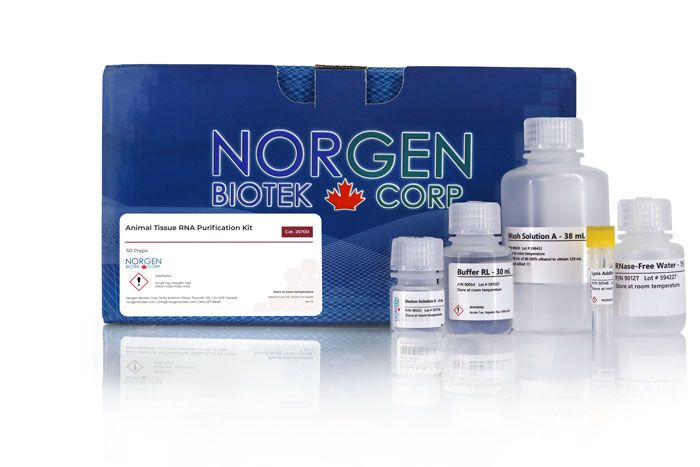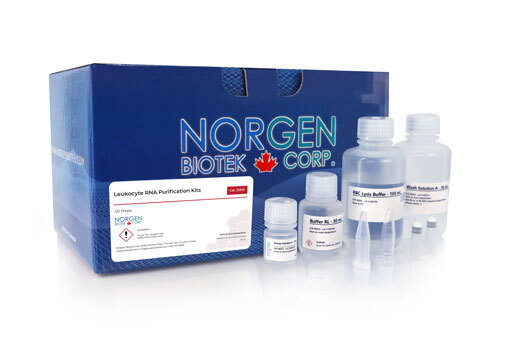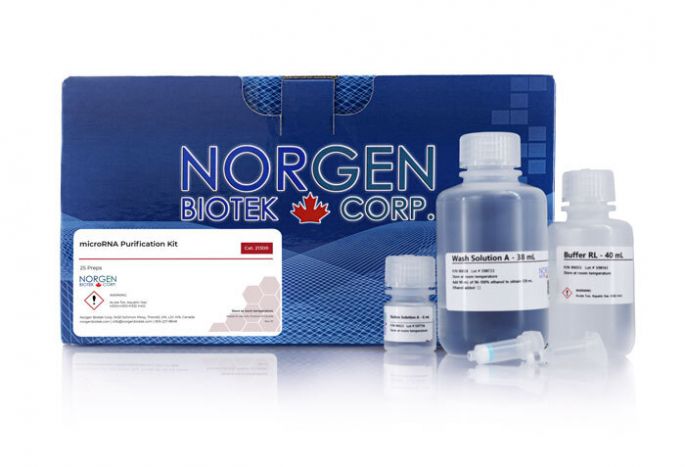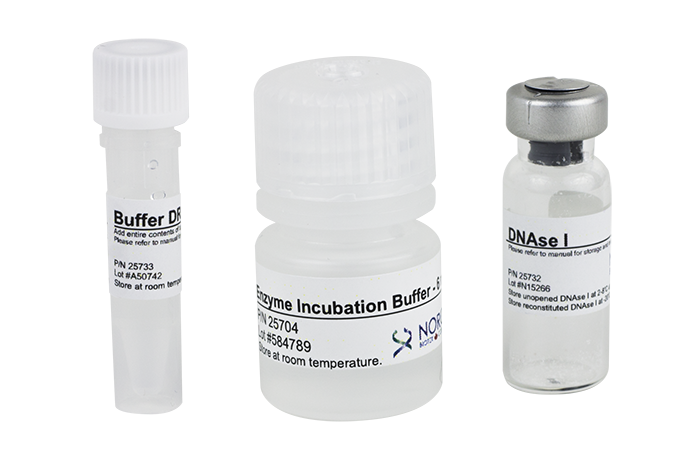Animal Tissue RNA Purification Kit
For purification of total RNA (including microRNA) from all types of tissues including fiber-rich tissues

For research use only and NOT intended for in vitro diagnostics.
Animal Tissue RNA Purification Kit
For purification of total RNA (including microRNA) from all types of tissues including fiber-rich tissues
Register today to receive an exclusive 15% off* on your first order.
Features and Benefits
- Extract high quality & quantity total RNA including miRNA
- Isolate from a wide variety of animal tissues
- No phenol step required - isolate all RNA in one fraction
- Compatible with tissues stored in RNAlater® or Trizol®
- Convenient & fast spin column format
- Purification is based on spin column chromatography that uses Norgen’s proprietary resin separation matrix
This kit is suitable for the isolation of total RNA from a range of animal tissues such as liver and spleen, as well as difficult fibrous tissues such as heart, muscle, intestine, etc. Briefly, the tissue of interest is first lysed using Buffer RL, followed by treatment with the provided Proteinase K which aids in the removal of the various proteins present in fiber-rich tissues including collagen, contractile proteins, and connective tissues. The purified RNA is of the highest quality and purity, with excellent RIN values and A260/A280, and is suitable for downstream applications including qRT-PCR, RT-PCR, microarrays, NGS, and more.
The kit purifies all sizes of RNA from large mRNA, lncRNA down to microRNA (miRNA) in the same fraction without the requirement of phenol. Isolate all RNA sequences at an equal rate irrespective of size. Moreover, when the RNA sequences are small (e.g. miRNA), the column binds small RNAs regardless of their GC content.
Details
Supporting Data
Figure 1. High Quality of Isolated RNA with Complete Size Range. Unlike most competitor’s kits, Norgen's Animal Tissue RNA Purification Kit allows for the isolation of all sizes of RNA, from the very large RNA down to the microRNA without the use of phenol. Total RNA was isolated from 25 mg samples of rat muscle using Norgen’s Animal Tissue RNA Purification Kit and a leading competitor's kit. Five microliters of the 50 µL RNA eluted from each kit were then resolved on a 1.2% formaldehyde-agarose gel. As it can be seen, only Norgen’s kit was able to isolate the full diversity of RNA species, including all the small RNA species
Figure 2. High Quality RNA Purification from a Diversity of Tissues. Norgen’s Animal Tissue RNA Purification Kit isolates high-quality RNA from a diversity of tissues including both tissues with high RNA content and fibrous tissues. Total RNA was successfully isolated from various tissue samples including 10 mg of spleen (Panel C), 10 mg of kidney (Panel D), and 25 mg of fiber-rich muscle (Panel B) using Norgen’s Animal Tissue RNA Purification Kit and a leading competitor's kit (Panel A). All RNA samples were eluted in a 50 µL volume. One microliter of each of the purified RNA samples was then analyzed using an Agilent BioAnalyzer on an RNA Nano 6000 Chip. All RNA samples resolved well in the Bioanalyzer suggesting high RNA quality. Moreover, small RNA could be observed in all the RNA samples isolated using Norgen’s kit (Panels B-D, circled), whereas no small RNA was present in the samples isolated using a competitors kit (Panel A).
Figure 3. Total RNA with High Yield of microRNA Species. Unlike most competitor kits that exclude RNA species of size < 200 nt, Norgen’s Animal Tissue RNA Purification Kit isolates the complete size range of total RNA including small RNAs. Total RNA was isolated from 25 mg of a rat muscle sample using Norgen’s Animal Tissue RNA Purification Kit and a leading competitor's kit as shown in Figure 1. Two microliters of the 50 µL isolated RNA were then subjected to a 20 µL reverse transcription using miR-21 stem-loop reverse primer or oligo dT. Two microliters of the reverse transcription was used in a 20 µL real-time PCR reaction with primers to detect the rat miR-21 (Panel A) and the beta-actin transcripts (Panel B), respectively. In both graphs, the blue lines correspond to Norgen isolated-RNA and the red lines correspond to competitor-isolated RNA. As it can be seen, Norgen’s kit isolated much higher yields of microRNA, as indicated by the lower Ct value of the blue line in Panel A. The kits isolated similar yields of mRNA as seen by the similar Ct values in Panel B. NTC corresponds to no-template control.
Figure 4. Compatibility with Tissues Stored in RNAlater®. Norgen’s Animal Tissue RNA Purification Kit can isolate total RNA from both flash frozen tissues and tissues stored in RNA preservation media such as RNAlater®. Total RNA was isolated from 10 mg of a hamster kidney sample, either flash frozen or stored in RNAlater®, using Norgen’s Animal Tissue RNA Purification Kit and a leading competitor's kit. Three microliters of the 50 µL isolated RNA were then subjected to a 20 µL reverse transcription using miR-21 stem-loop reverse primer or oligo dT. One microliter of the reverse transcription was used in a 20 µL real-time PCR reaction with primers to detect the hamster miR-21 (Panel A) and the beta-actin transcripts (Panel B), respectively. In both graphs, the blue lines correspond to Norgen isolated-RNA and the red lines correspond to competitor-isolated RNA, both from RNAlater®-preserved samples. The green lines correspond to Norgen isolated-RNA from flash frozen samples. As it can be seen, Norgen’s kit isolated similar amounts of both mRNA and microRNA from either frozen or RNAlater®-preserved samples, as shown by the similar Ct values of the blue and green lines. In addition, Norgen’s kit isolated much higher yields of microRNA than the competitor’s kit, as indicated by the lower Ct value of the blue and green lines in Panel A. The kits isolated similar yields of mRNA as seen by the similar Ct values in Panel B. NTC corresponds to no-template control.
|
Kit Specifications
|
|
|
Maximum Column Binding Capacity
|
50 μg
|
|
Maximum Column Loading Volume
|
650 μL
|
| Size of RNA Purified |
All sizes, including small RNA < 200 nt
|
| Time to Complete 10 Purifications |
50 minutes
|
| Average Yield Liver (10mg) Kidney (10mg) Spleen (10mg) Heart (10mg) Muscle (10mg) |
30 μg 25 μg 15 μg 10 μg 5 μg |
| Maximum Amount of Starting Material Heart Kidney Liver Muscle Spleen |
30 mg 15 mg 15 mg 30 mg 15 mg |
Storage Conditions and Product Stability
The DNAse I should be stored at -20°C upon arrival. The Proteinase K should be stored at -20°C upon arrival and after reconstitution. All other solutions should be kept tightly sealed and stored at room temperature. This kit is stable for 1 year after the date shipment.
| Component | Cat. 25700 (50 preps) |
|---|---|
| Buffer RL | 30 mL |
| RNase-Free Water | 40 mL |
| Wash Solution A | 38 mL |
| Enzyme Incubation Buffer A | 6 mL |
| Elution Solution A | 6 mL |
| Proteinase K | 2 vials |
| DNase I | 1 vial |
| Mini Spin Columns | 50 |
| Collection Tubes | 100 |
| Elution Tubes (1.7 mL) | 50 |
| Product Insert | 1 |
Documentation
FAQs
Spin Column
Poor RNA recovery could be due to one or more of the following:
- Incomplete lysis of cells or tissue.
Ensure that the appropriate amount of Buffer RL was used for the amount of cells or tissue. - Column has become clogged.
Do not exceed the recommended amounts of starting materials. The amount of starting material may need to be decreased if the column shows clogging below the recommended levels. See FAQ related to “Clogged Column” below. - An alternative elution solution was used.
It is recommended that the Elution Solution A supplied with this kit be used for maximum RNA recovery. - Ethanol was not added to the lysate.
Ensure that the appropriate amount of ethanol is added to the lysate before binding to the column. - Ethanol was not added to the Wash Solution A.
Ensure that 90 mL of 96 - 100% ethanol is added to the supplied Wash Solution A prior to use. - Low RNA content in tissue used.
Different tissues have different RNA contents, and thus the expected yield of RNA will vary greatly from these different sources. Please check literature to determine the expected RNA content of your starting material. - Insufficient solubilization of tissues.
Ensure the lysate is diluted with the appropriate amount of RNase-free water, and that the appropriate amount of Proteinase K is added. Also ensure that the Proteinase K treatment is performed at 55°C for the full 15 minutes. The incubation time can be increased up to 30 minutes if required.
Column clogging can result from one or combination of the following factors:
- Insufficient solubilization of tissues.
Ensure the lysate is diluted with the appropriate amount of RNase-free water, and that the appropriate amount of Proteinase K is added. Also ensure that the Proteinase K treatment is performed at 55°C for the full 15 minutes. The incubation time can be increased up to 30 minutes if required. - Maximum amount of tissue exceeds kit specifications.
Refer to specifications to determine if the amount of starting material falls within kit specifications. - High amounts of genomic DNA present in sample.
The lysate may be passed through a 25 gauge needle attached to a syringe 5-10 times in order to shear the genomic DNA prior to loading onto the column. Also, ensure that the on-column DNase treatment is performed if high amounts of genomic DNA are found in the sample. - Centrifuge temperature is too low.
Ensure that the centrifuge remains at room temperature throughout the procedure. Temperatures below 15°C may cause precipitates to form that can cause the columns to clog.
RNA can be degraded due to the following factors:
- RNase contamination.
RNases may be introduced during the use of the kit. Ensure proper procedures are followed when working with RNA. Please refer to “Working with RNA” at the beginning of this user guide. - Procedure not performed quickly enough.
In order to maintain the integrity of the RNA, it is important that the procedure be performed quickly. This is especially important for the Cell Lysate Preparation Step in the protocol, since the RNA in animal tissues is not protected after harvesting until it is disrupted and homogenized. - Improper storage of the purified RNA.
For short-term storage, RNA samples may be stored at –20°C for a few days. It is recommended that samples be stored at –70°C for longer-term storage. - Frozen tissues were allowed to thaw prior to RNA isolation.
Do not allow frozen tissues to thaw prior to grinding with the mortar and pestle in order to ensure that the integrity of the RNA is not compromised.
If the RNA does not perform well in downstream applications, it may be due to one or more of the following:
- RNA was not washed 2 times with the provided Wash Solution A.
Traces of salt from the binding step may remain in the sample if the column is not washed 2 times with Wash Solution A. Salt may interfere with downstream applications, and thus must be washed from the column. - Ethanol carryover.
Ensure that the dry spin under the Column Wash procedure is performed, in order to remove traces of ethanol prior to elution. Ethanol is known to interfere with many downstream applications.
Genomic DNA contamination could be caused by the following:
- Large amounts of starting material used.
Perform the RNase-free DNase I digestion on the RNA sample suggested in the protocol to remove genomic DNA contamination. - DNase I mix did not completely pass through the column during DNase I treatment.
Ensure the entire 115 µL of DNase I mix passes through the column. If needed, spin at 14,000 x g (~14,000 rpm) for 1 minute.
Citations
| Title | Placental transcriptome variation associated with season, location, and urinary prenatal pyrethroid metabolites of Thai farm-working women |
| Citation | Environmental Pollution 2024. |
| Authors | Yewei Wang a, Karen Hermetz a, Amber Burt a, Elizabeth M. Kennedy a, Corina Lesseur b, Parinya Panuwet a, Nancy Fiedler c, Tippawan Prapamontol d, Panrapee Suttiwan e, Warangkana Naksen f, Dana Boyd Barr a, Ke Hao b, Jia Chen b, Carmen J. Marsit a |
| Title | Maternal supplementation with n-3 fatty acids affects placental lipid metabolism, inflammation, oxidative stress, the endocannabinoid system, and the neonate cytokine concentrations in dairy cows |
| Citation | Journal of Animal Science and Biotechnology 2024. |
| Authors | Priscila dos Santos Silva, Gitit Kra, Yana Butenko, Jayasimha Rayalu Daddam, Yishai Levin & Maya Zachut |
| Title | Associations between prenatal organophosphate pesticide exposure and placental gene networks |
| Citation | Environmental Research 2023. |
| Authors | Qian Li, Corina Lesseur, Pranathi Srirangam, Kirtan Kaur, Karen Hermetz, W. Michael Caudle, Nancy Fiedler, Parinya Panuwet, Tippawan Prapamontol, Warangkana Naksen, Panrapee Suttiwan, Brittney O. Baumert, Ke Hao, Dana Boyd Barr, Carmen J. Marsit, Jia Chen |
| Title | The rat Achilles and patellar tendons have similar increases in mechanical properties but become transcriptionally divergent during postnatal development |
| Citation | the journal of physiology 2023. |
| Authors | Danielle Steffen, Alec Avey, Michael J. Mienaltowski, Keith Baar |
| Title | Panicum miliaceum L. and Bone Healing Properties in Rat Model of Femur Fracture by Activating Phosphate Stimulating Macrophages via BMP2 and RANK Signaling Pathway |
| Citation | Pharmacognosy Magazine 2023. |
| Authors | Yubing Zhang, Qiu Wang, Hansong Pan, Hongye Xu, Wei Deng, and Xiaohai Sun |
| Title | Developmental bisphenol S toxicity in two freshwater animal models |
| Citation | Environmental Toxicology and Pharmacology 2023. |
| Authors | Hayley Neighmond, Abigail Quinn, Benjamin Schmandt, Kerry Ettinger, April Hill, Larissa Williams |
| Title | Early intestinal development and mucin transcription in the young poult with probiotic and mannan oligosaccharide prebiotic supplementation |
| Citation | Poultry Science 2016. |
| Authors | S. L. Hutsko, K. Meizlisch, M. Wick, and M. S. Lilburn1 |
| Title | Analyzing tumor heterogeneity and driver genes in single myeloid leukemia cells with SBCapSeq |
| Citation | Nature Biotechnology 2016. |
| Authors | Mann, K. M., Newberg, J. Y., Black, M. A., Jones, D. J., Amaya-Manzanares, F., Guzman-Rojas, L., ... & Yew, C. C. K |
| Title | Transposon mutagenesis identifies genes that cooperate with mutant Pten in breast cancer progression |
| Citation | PNAS 2016. |
| Authors | Rangel, R., Lee, S. C., Ban, K. H. K., Guzman-Rojas, L., Mann, M. B., Newberg, J. Y., ... & Rust, A. G |
| Title | RNA sequencing of pancreatic adenocarcinoma tumors yields novel expression patterns associated with long-term survival and reveals a role for ANGPTL4 |
| Citation | Molecular Oncology 2016. |
| Authors | Kirby, M. K., Ramaker, R. C., Gertz, J., Davis, N. S., Johnston, B. E., Oliver, P. G., ... & Posey, J. A |



